A once rapturous super-team at the pinnacle of European and world football, Barcelona have fallen from unimaginable heights over the past three years.
Ernesto Valverde, Quique Setién, and Ronald Koeman all tried and ultimately failed to bring La Blaugrana back to the summits of the Pep Guardiola and Luis Enrique era. The man now tasked with taking the side from the destitution of desolation is a man who was a key player during their previous two treble-winning seasons in 2009 and 2015 – Xavier Hernandez.
The Spaniard, more commonly referred to as ‘Xavi’, is lauded as one of the greatest midfielders of all time. It turns out, he’s not too bad as a coach either. The 42-year-old won seven trophies as the manager at the Qatar Stars League champions Al-Sadd, including the league title in the 2020/21 season.
Xavi was handed the Barcelona job at the beginning of November 2021 and his legendary status was undoubtedly a major factor in this. However, the young coach has come home to the Nou Camp with a wonderfully exciting style of football for the fans to devour.
It’s so far, so good for the La Masia graduate as Xavi has the side playing some wonderfully expansive football despite having quite a slow, toothless start to his reign.
This article will be a tactical analysis of Barcelona under Xavi. It will be an analysis of the tactics that have defined his tenure so far with the Catalans.
Style of play
Xavi’s style of play has been compared to that of his former mentor Guardiola. This is an obvious link given that the prestigious coach has been such a key figure in Xavi’s career. Watching Barcelona under the inexperienced manager, there are certainly ‘Pep-isms’ within the side and Guardiola has undoubtedly had a major impact on how Xavi sees the game from the touchline.
Both men are keen on having the ball as well as maintaining the key principles of ‘Juego de Posicion’ (positional play), made notorious by Guardiola himself. Speaking in an interview with FIFA back in 2019, Xavi spoke about the way he wants his sides to play:
“I’d describe myself as someone who likes to have the ball. I’m there in the dugout suffering if my team doesn’t have the ball. It was the same when I played: I loved being on the ball. What I want is for my team to have control and I think you have that when you have the ball.
“That’s my philosophy: to have possession high up the pitch – not just sitting and waiting – and to go on the attack, because the more chances you create, the more chances you have to win.”
Xavi has certainly stayed true to these principles as, unsurprisingly, Barcelona have dominated the possession charts in La Liga under his guidance.
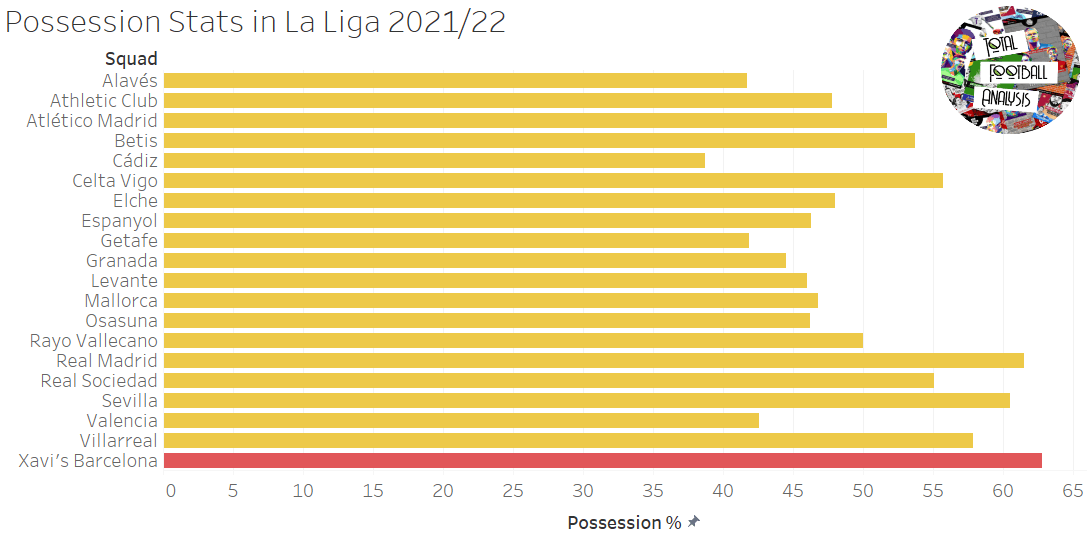
However, while Pep’s influence is apparent within the current Barca team’s fluid style of football, there are also many differences between the two managers’ approaches.
Xavi’s side are much more direct and have proven themselves to be very adept in attacking transitions, among other elements not usually representative of a Guardiola team. Analysing the data available, while Manchester City have attempted way more passes than Xavi’s Barca on a per 90 basis, the latter are averaging more long balls.
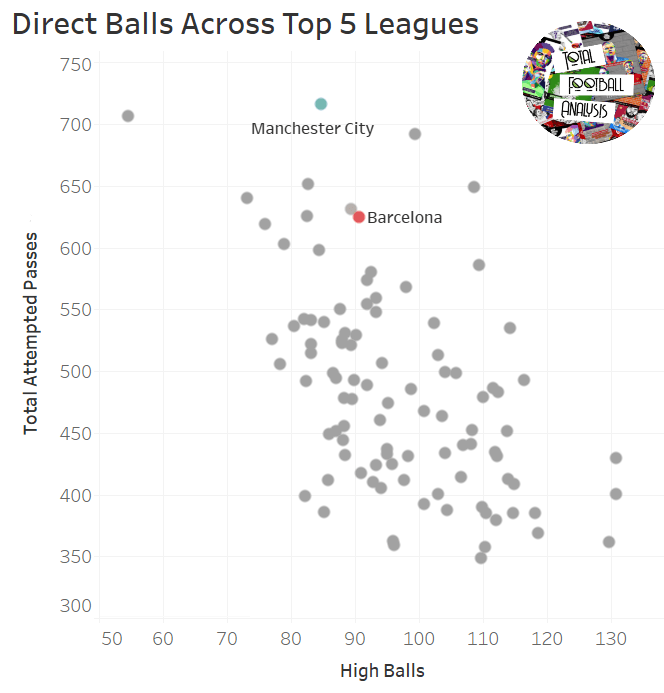
This is most definitely not a declaration that Xavi has centred his entire philosophy with the Catalan giants around long passes and second balls like a Burnley or a Getafe but there is an emphasis on drawing the opposition into deep areas where applicable before trying to play over them.
This won’t always be plausible but is certainly a useful tool in Barca’s refurbished arsenal, particularly when an opponent is pressing high up the pitch.
Inviting pressure to go long
As with most modern coaches, Xavi wants his side to build out from the back, splitting the centre-backs, creating width and depth with the players’ positioning on the field. The Spaniard’s 4-3-3 system allows him to execute this perfectly given the players at his disposal, although Xavi hasn’t been a stranger to employing a 4-2-3-1 on the odd occasion.
La Blaugrana have had some difficult matches as of recently in all competitions. The sides they have faced, including two legs against Napoli in the Europa League as well as Atletico Madrid, Valencia and Athletic Bilbao in La Liga, have all looked to press them high to stifle their build-up play and attempt to win the ball closer to the goal.
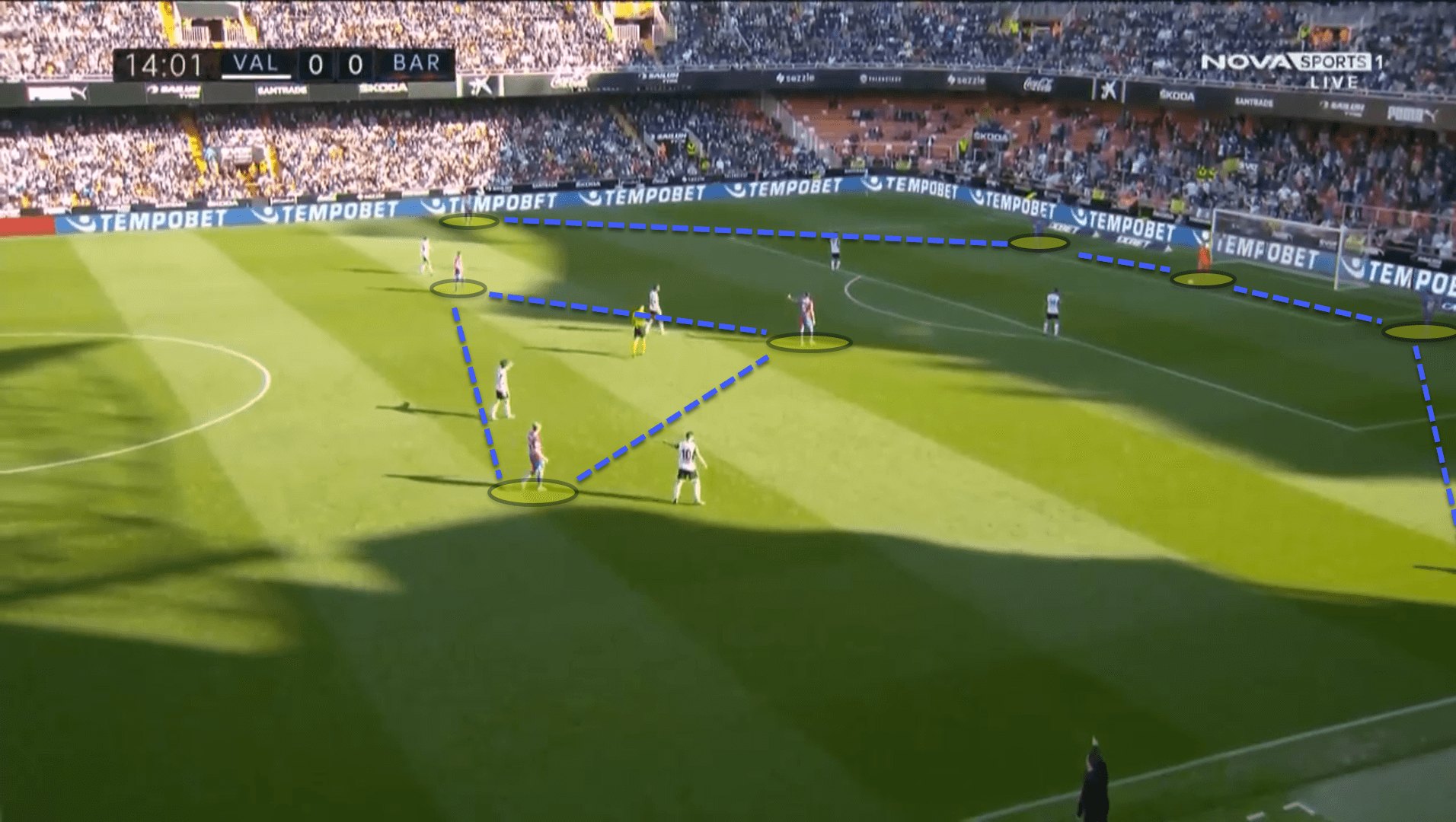
There are different approaches when building out from the backline. Where a side like Man City or a Chelsea will likely look to play their way out on the floor, using one-touch passes and wide combinations, Barcelona have opted to take an alternative approach in recent matches.
Against Valencia and Napoli in the second leg, Barcelona were setting up to play out from the back, keeping the fullbacks low during the build-up phase and dropping the midfielders deep in order to create separations amongst the opposition’s lines.
In the previous image, Valencia are pressing Barca high up the pitch in a 4-4-2 high block. The midfield and forward line are very high during their press, but the back four are pinned back at the halfway line by Barca’s front three. This allows Barca to go long to the striker or else to the wingers attacking the depth.
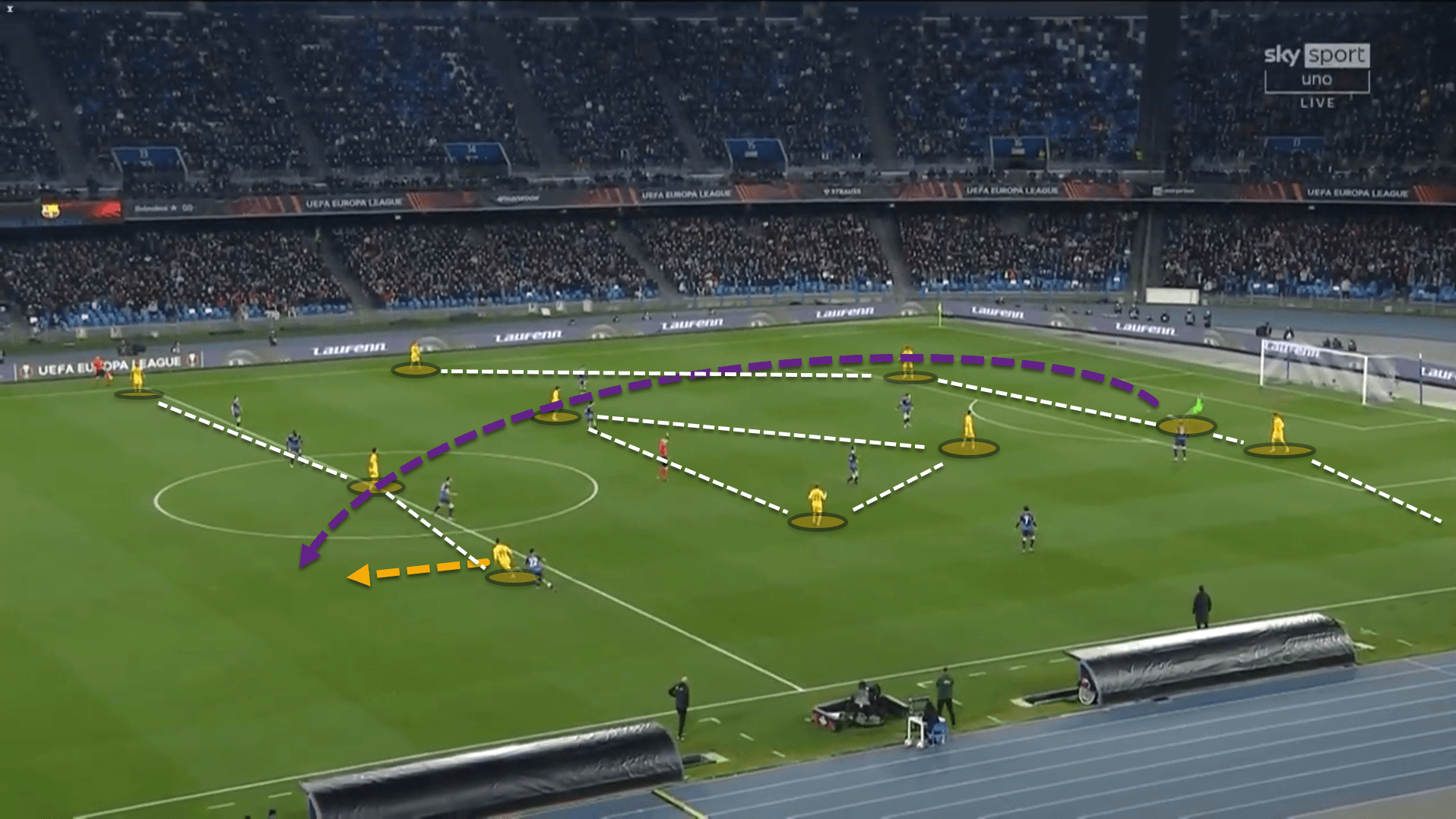
This was Barca’s second goal against Napoli in an enthralling 4-2 win at the Stadio Diego Armando Maradona. Barcelona invited Napoli to press them in deeper areas by positioning their players low whilst keeping the forward line high and wide.
Marc-André ter Stegen found Ferran Torres running in behind. The ball eventually fell to Frenkie de Jong who scored an utterly sumptuous curler into the top-right corner. While the emphatic finish was a moment of magic from the Dutchman, the build-up to the goal was a well-worked tactical plan from the head coach as Barca had tried it numerous times beforehand.
Direct to the striker
Pierre-Emerick Aubameyang, who has been starting as Xavi’s lone striker in the 4-3-3, has been another option from direct balls from the build-up phase. While the former Arsenal man does make runs in behind, he is also very adept at dropping short to receive the ball to feet.
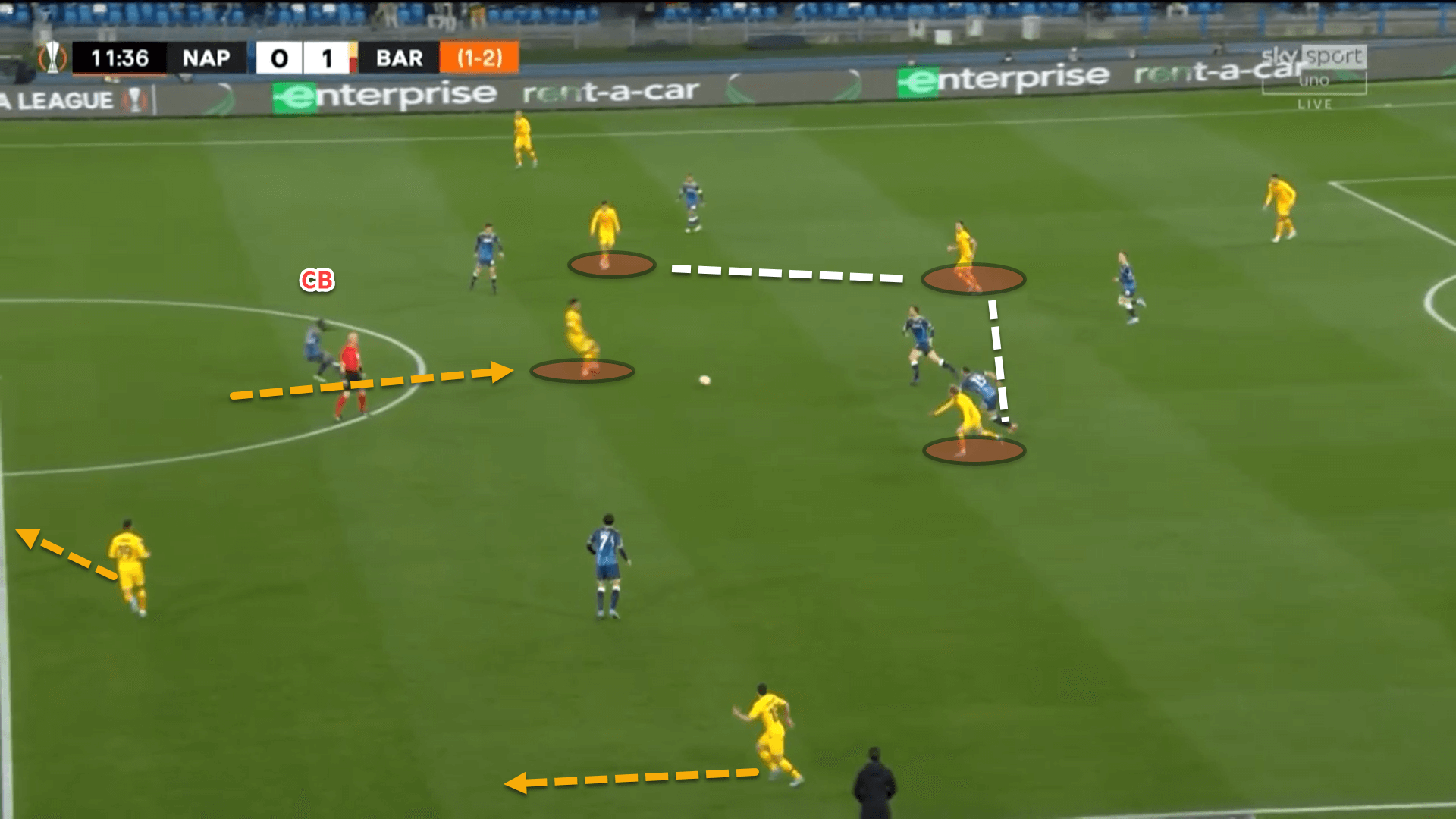
Here, Barcelona have been easily able to bypass Napoli’s press by using the movement of Aubameyang to play to the Gabonese forward’s feet. This has dragged the centre-back out, creating space for runners to exploit.
Using Aubameyang in deeper positions has been a way for Xavi to break down high defences by creating third-man runs. These glorious passing patterns are a key component to the young coach’s philosophy and Xavi has infamously spoken about their importance in the past, saying: “the third man is impossible to defend against”.
Essentially, when Aubameyang drops, players support him with runs in behind and movements in front so that he can lay the ball off to the third man. From there, Barca can generally find the fourth man who is running in behind.
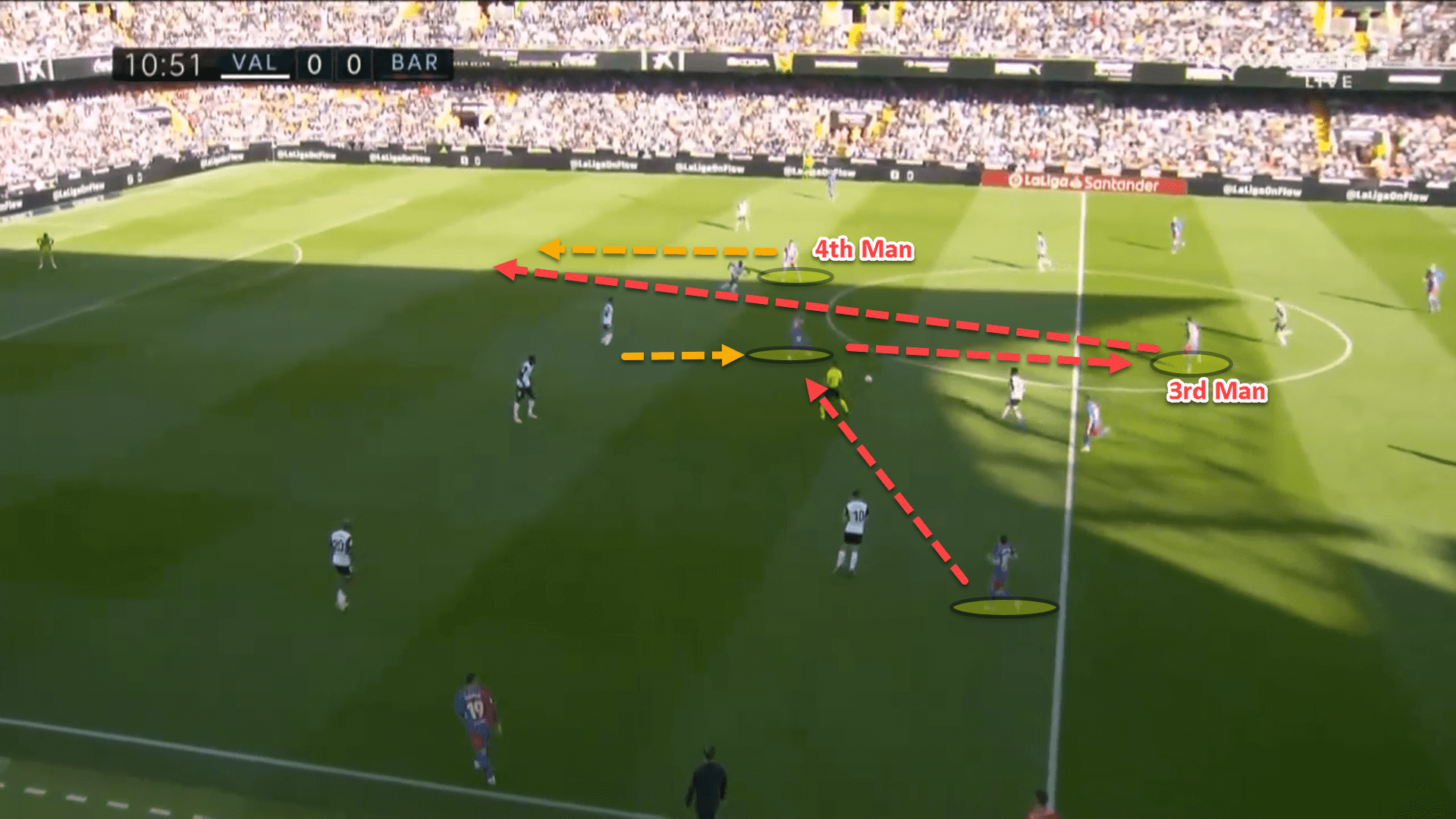
In this instance, Aubameyang has dropped to receive from Alba, bounced it off to Sergio Busquets, the third man in the passing move, before sliding it through to the fourth man making a run in behind. This is an excellent example of an ‘up-back-through’ passing pattern which is used very often in Marcelo Bielsa’s teams.
Third and fourth-man runs are a wonderful way to break down a defensive block, irrespective of how deep the opposition are sitting and Xavi’s side are extremely well-drilled at doing so.
These types of passing sequences also play into the true narrative that Barca are far more direct under the new coach than in previous years. Their play is vertical, and Xavi wants the ball to be moved with purpose and precision, and to be shifted through the thirds quickly.
These passes to try and find the feet of the dropped centre-forward don’t necessarily have to just come from the build-up phase in order to play vertically as quick as possible. Barcelona also look for this option during settled positional attacks.
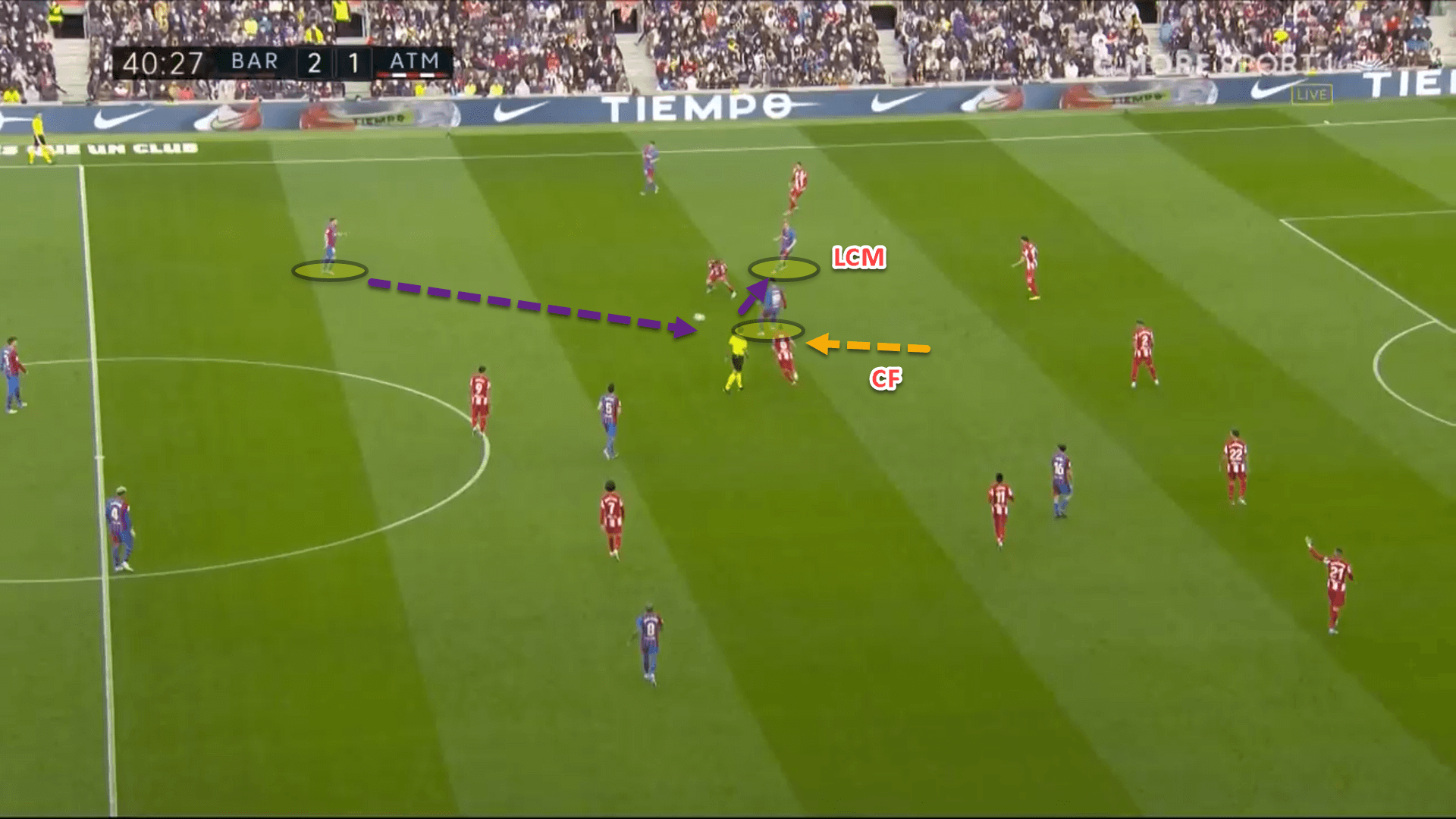
In this situation, the ball to the left central midfielder was blocked off by the Atletico midfielder. Alba played it to Torres who was operating as the make-shift number ‘9’. The former Man City forward had the option to be a wall pass and lay the ball to the third man, Frenkie de Jong, in the left halfspace who was on the blindside of the opponent’s midfielders and in an optimal position to receive and drive the ball forward.
Under Xavi, Barcelona use the third man concept constantly and efficiently as a way to break down low blocks. The four-time European champions were finding their feet at first but recently have looked absolutely splendiferous with their use of the third and fourth man in the final third.
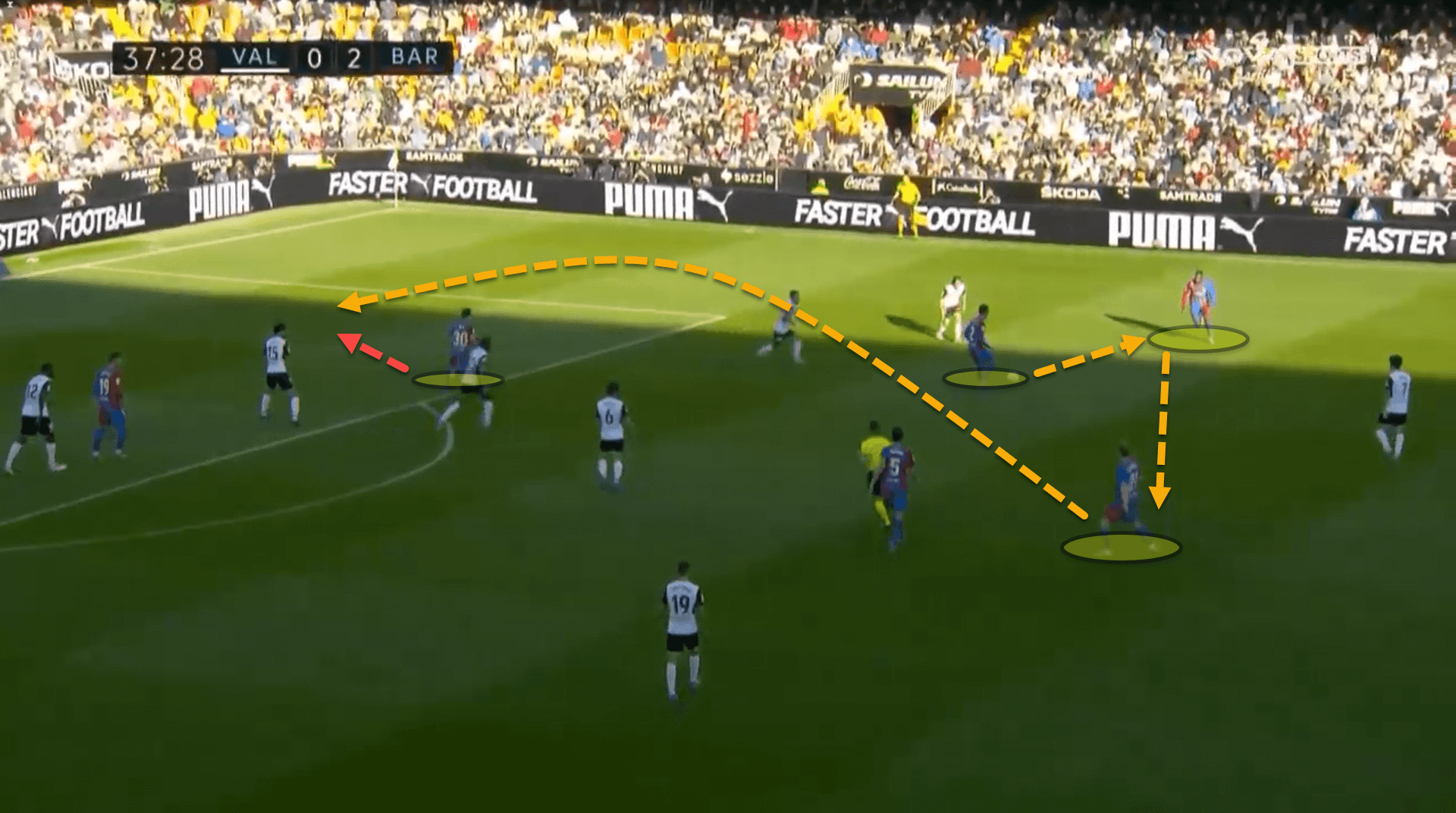
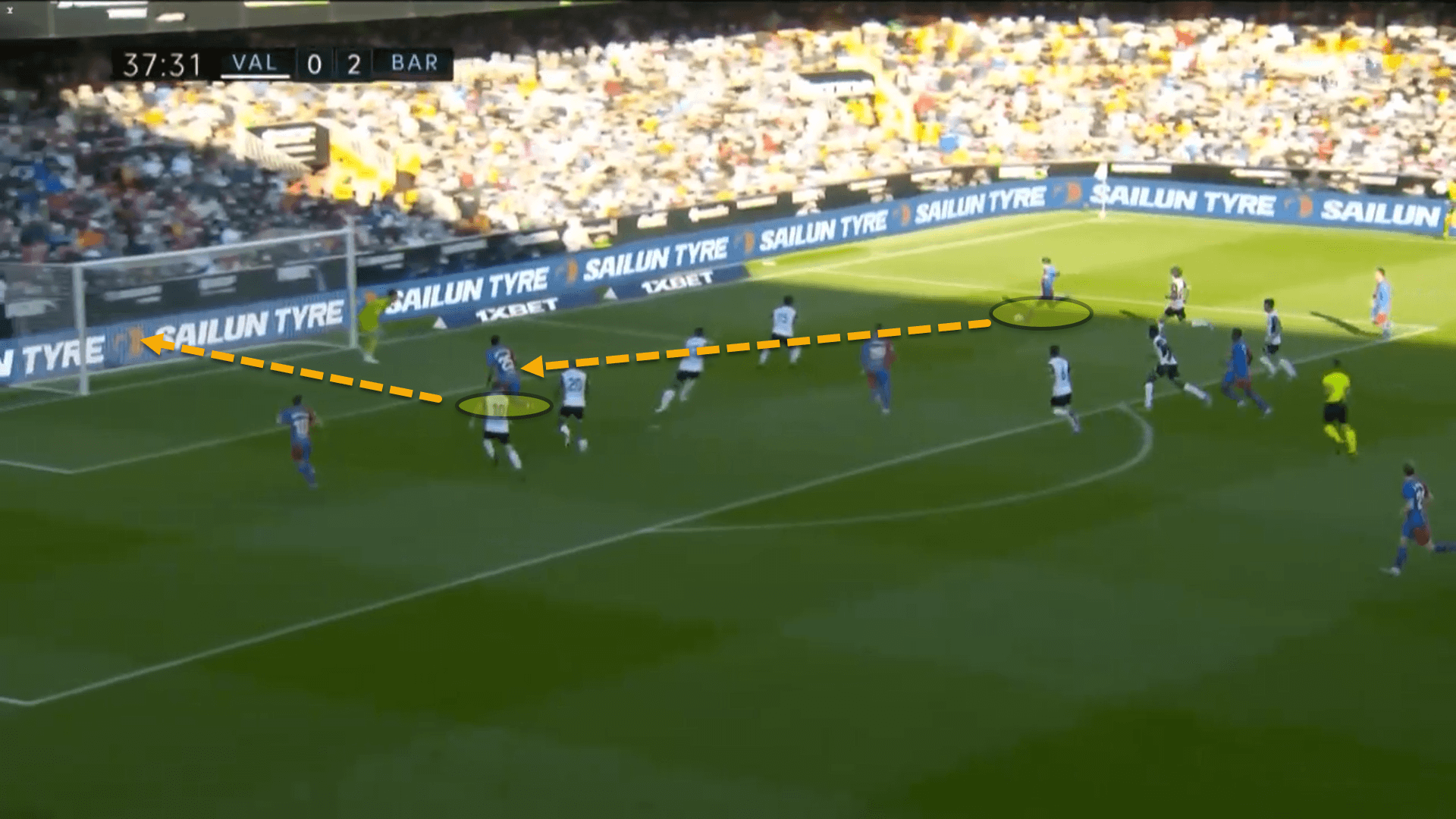
Incredibly high pressing
As with building out from the back, Xavi wants his side to subscribe to another element of modern football through pressing high up the pitch. Most sides commit multiple bodies in the press, but Xavi has taken his side’s tactical set-up in this phase to near-Bielsa levels.
Since his arrival, Barcelona have applied more successful pressures all over the pitch than any other side in La Liga with 34.4 per 90. While they haven’t applied the most pressures in the final third (as the graph below will portray), Xavi’s men are the best pressers in Spain’s top-flight division.
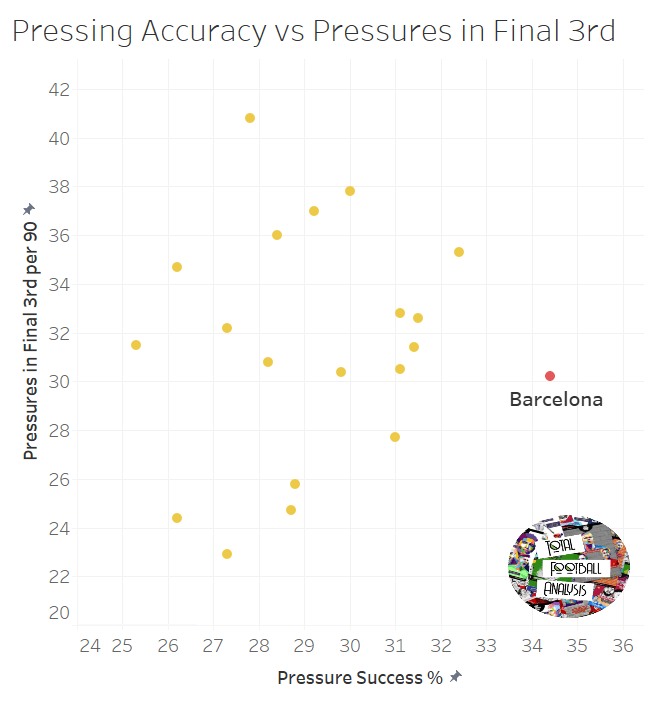
With pressing, the reward is mouth-watering while the risk is quite worrisome. Coaches have found ways to ensure that the team are balanced in the press so that the backline isn’t overly exposed should the first wave of pressure get broken. Usually, one of the midfielders will sit back and play zonally to protect the backline from any direct balls pumped over the press.
Nevertheless, Xavi has taken inspiration from another one of his former mentors, Luis Enrique. Here is an example of Spain’s pressing under Enrique in a 6-0 thrashing of Germany back in 2020.
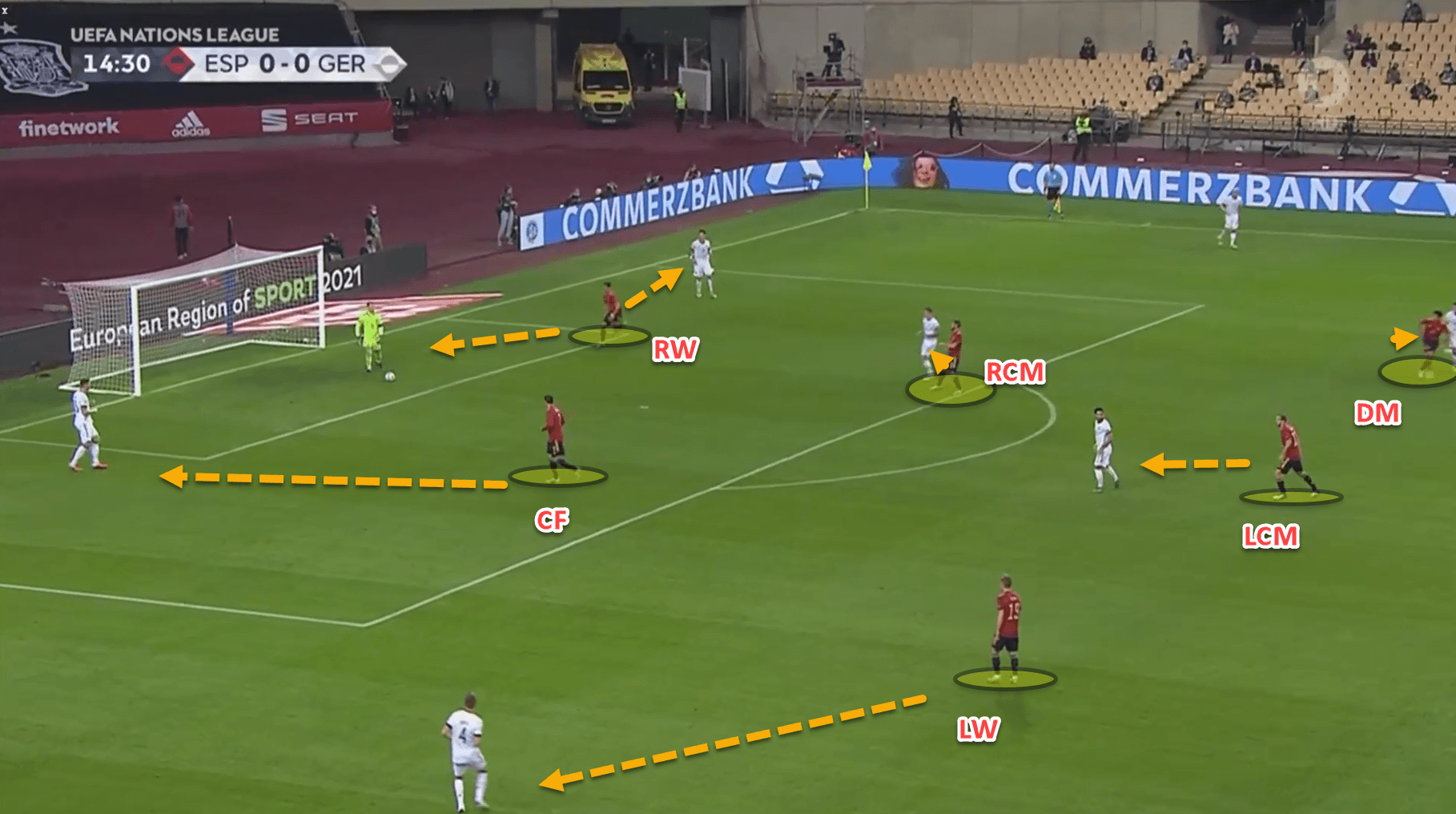
The press is man-oriented and extremely rigid. The most striking aspect of Enrique’s press with Spain is that no player is kept back to protect the backline in case the press is broken or the opponent goes long over it.
For example, Rodri was deployed as Spain’s holding midfielder against Germany by the national team coach but instead of staying back, the ex-Atletico star is man-marking a German midfielder on the cusp of the final third. Now, let’s take a look at Xavi’s Barcelona:
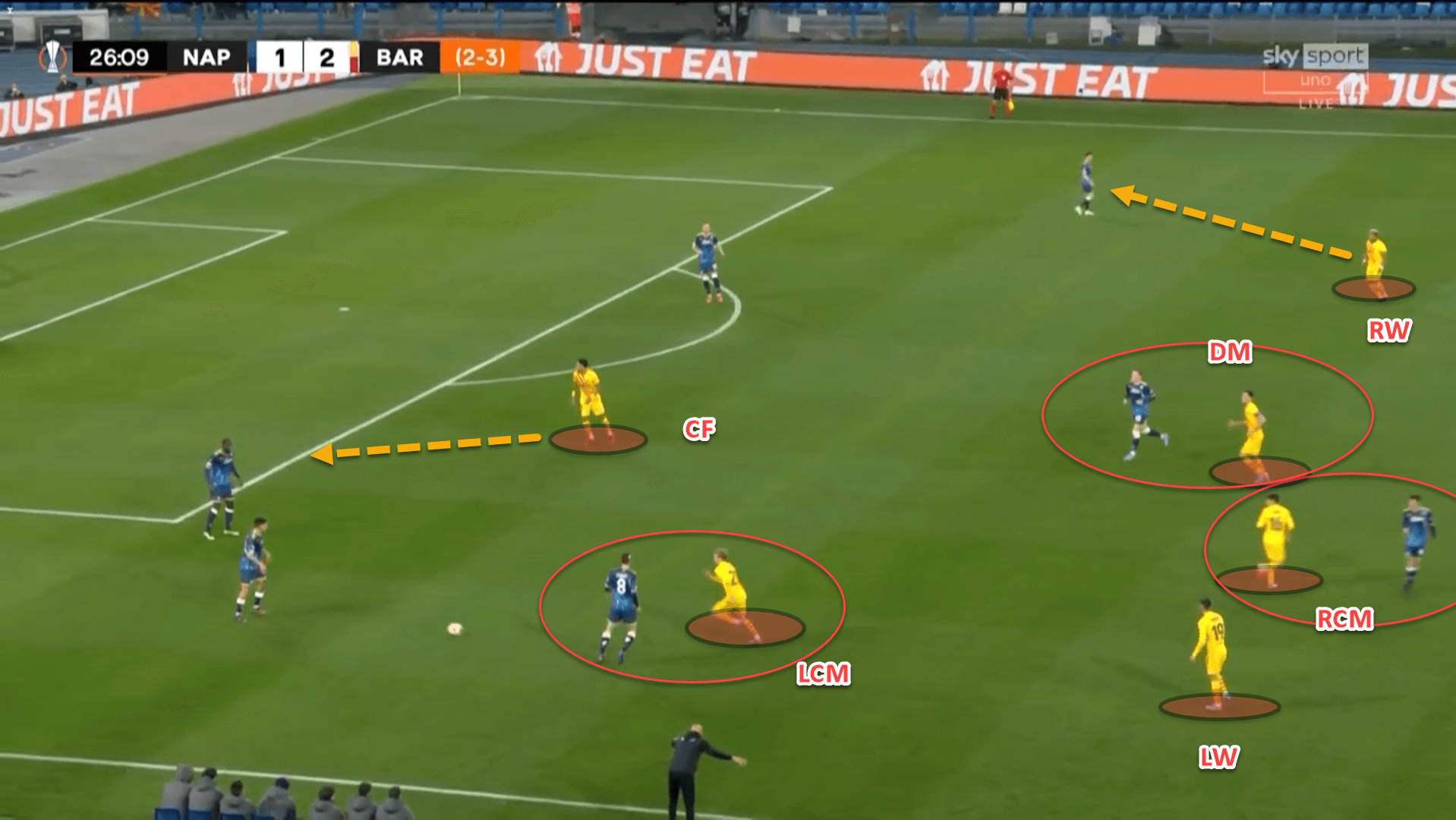
To use a common Irish phrase, Xavi certainly didn’t lick it off the stones. Much like Spain’s extreme pressing, Barcelona have been using a man-to-man marking scheme in the high press, as highlighted in this image. This is not the only similarity though. Busquets, Barca’s ‘6’, has also pushed very high up the pitch to mark his player just as Rodri did for Enrique’s Spain.
This is a very risky form of pressing and has proven to be detrimental to the Catalan giants already. If the team in possession can bypass the first and second line of pressure, Xavi’s side are in trouble due to the high positioning of the number ‘6’. This high-reward tactical ploy leaves the backline very exposed because of the wealth of space in front of them not being covered.
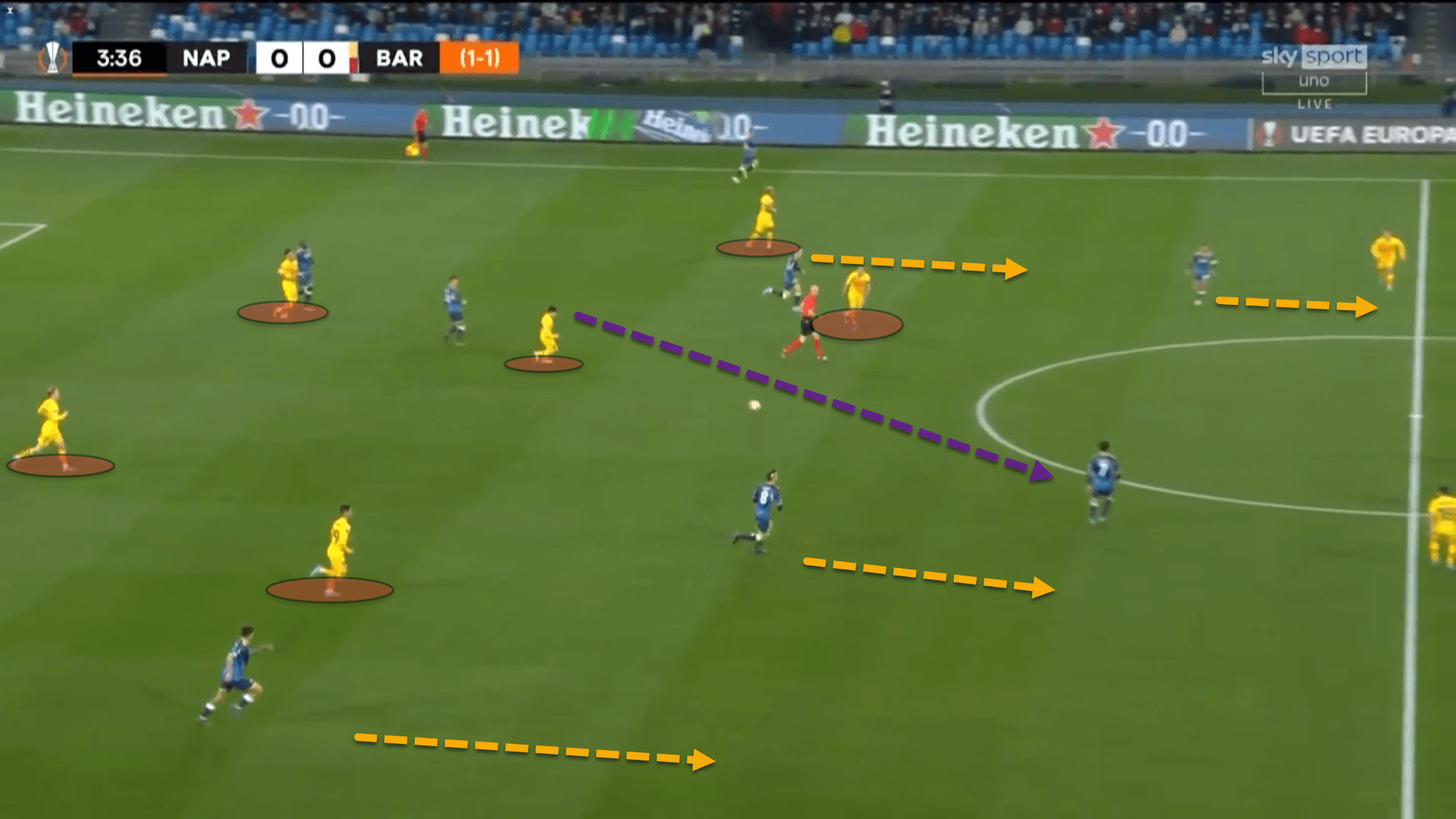
Conclusion
Barcelona certainly aren’t reinventing the wheel under Xavi as they did during Pep’s illustrious time at the Nou Camp. However, the new head coach is certainly doing his unintentional best to falsify the narrative that he is a ‘mini-Guardiola’ – something that has hung over Mikel Arteta throughout his tenure with Arsenal.
Xavi’s Barca are far more resemblant of a side led by Luis Enrique while there are also quite a few Bielsa-isms in the team’s system of play. The football is exhilarating, and Xavi has turned Barcelona from a side on a freefall off a bottomless cliff to one of the most exciting teams in Europe once again. Nuevo rey, nueva ley.






Comments